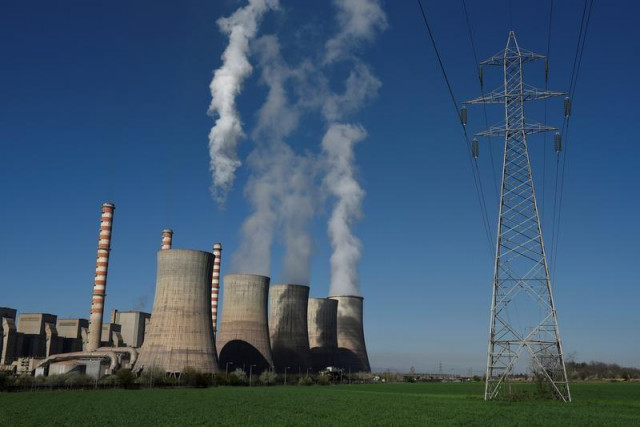Govt may do away with inefficient plants
Should also plug leakages, reduce T&D losses to heal the ailing sector

A view of the coal-fired power station. PHOTO: REUTERS
Other questions are what to do with the retiring power plants which have adequate efficiency and are still good to run; how to add a reasonable amount of renewable energy despite a purported surplus in the near term and in the face of financial crunch?
Let us first examine the status of power generation. Following conclusions emerge from examining the data of November and December 2018, compiled by Nepra/CPPA-G.
The capacity of hydroelectric power production has increased to 9,000 megawatts with the inclusion of Neelum-Jhelum and Tarbela-IV projects, which added 2,300MW.
In December, however, the hydroelectric power production went down to 1,334 million kilowatt-hours (kWh) from 2,564 million kWh in November, a decrease of 48%, which is understood for seasonal reasons. The reduction has been met partly by utilising furnace oil plants, which provided literally no electricity in November and in December it came back to 12% of the total. Furnace oil has been probably inducted in December on the insistence of oil refineries, which faced a shutdown.
Coal-based electricity share in total generation increased from 13% in November to 20.2% in December. Their total capacity, at 80% capacity factor, is supposed to be 1,800 million kWh, which, however, produced only 1,563 million kWh in December and only 1,042 million kWh in November. Coal power is supposed to be the cheapest. It should produce more.
In November, re-gasified liquefied natural gas (RLNG) generated 1,300 million kWh, while in December, it came down to only 933 million kWh. Balloki plant did hardly produce any significant volumes. RLNG plants are based on ‘take or pay’ contract for LNG supply. It is hoped that RLNG is diverted to other sectors and is not wasted.
Unstable oil prices
Brent crude oil prices are unstable at best. Year 2018 started with Brent prices at $69 a barrel, which increased to $80. Brent is now trading at around $60. It would be good news, if oil prices remain at this level, although in 2014, oil prices went as low as $40.
If Brent remains at $60, the prices of fuels like coal, furnace oil (RFO), local gas and RLNG would go down by 20-25%. As one can see, coal is the cheapest source at $4.54 per million British thermal units (mmbtu) but its advantage is slightly reduced because of low-efficiency (42%) plants as compared to RLNG plants having 60% efficiency.
RLNG prices are $11.3 per mmbtu as opposed to $14 for RFO. There is a price advantage of 20% in RLNG in comparison to RFO. This advantage is increased by high-efficiency (60%) combined-cycle power plants with fuel cost per kWh of 6.43 US cents for RLNG vs 11.37 US cents for RFO.
RFO price is slightly less than double. Local gas prices are almost half that of RLNG. The price effect gets even more pronounced with local gas wherein fuel cost per kWh in high-efficiency plants becomes 3.41 US cents vs 11.37 cents for RFO, a difference of three times. However, cheap local gas prices are a double-edged weapon - they help keep energy mix prices low but simultaneously lead to less optimum allocation of resources.
Generation companies’ (Gencos) lowest thermal efficiency plants are quite early in the merit order and are running due to the cheap local gas. If priced at RLNG levels, these plants would never be able to operate and will be at the end of the merit order. There is a strong case for shutting down these plants with a few exceptions.
Inefficient plants
There is 6,000MW of thermal power plants under the public sector Gencos, which have a fuel cost of 16 to 20 cents per unit.
Only two power plants, namely Guddu combined-cycle (747MW) and Nandipur (567MW), have somewhat acceptable thermal efficiency of 40% or above. Except these two, all other plants in this category may be shut down. Another 5,000-6,000MW of thermal independent power plants (IPPs) are to retire in the coming decade ending 2030. Important ones among these are 1,600MW Kapco – retiring in 2021 - and 1,262MW Hubco - retiring in 2027.
Out of the 10 plants in this category, four have thermal efficiency, of less than 40% and should be retired as their agreements expire. There are other plants such as Kapco, Rousch, etc, which have higher efficiencies of 43.7% and 47% respectively.
Higher efficiency plants such as these may be considered for extension on a take-and-pay basis. These may also be ideal candidates for putting them under the proposed energy exchange. A policy should be devised in this respect. The power plants may need balancing, modernisation and replacement (BMR) for which they would require time to plan, arrange financing and implement. There is a CPP cost of 4.5 cents for new power plants but they would have higher thermal efficiency of 50-60%.
One has to calculate the cut-off point where it may be of interest for both the operators and the buyer. Power planners should provide for a retiring capacity of 8,000-10,000MW from generation companies and the IPPs.
Small IPPs running on internal combustion engines aggregate to about 2,000MW and run on RFO. These are mostly efficient power plants with some combined-cycle capabilities. To be able to run local refineries, one has to run RFO power plants of some 2,000-2,500MW.
In winters, there is no or very little hydel production, creating a space for these RFO plants and use of RFO. However, another 2,000MW of cheap coal power is coming up soon. Are we in a capacity trap?
If the textile sector picks up following devaluation and energy price incentives, demand may pick up as well. However, in the wake of forecasts of lower growth rates of economy, the demand may not grow much.
Renewable energy
It is now obvious that the time of renewable energy has arrived. Internationally, solar projects are being installed at 2-3 US cents. In Pakistan, due to credit rating and interest rate issues, solar and wind plants could be installed at 5-6 US cents.
Hydroelectric power, however, has become expensive from the traditional one rupee to 10 US cents. Many hydel projects are in the pipeline. In the current circumstances, there is a case for installing at least 5,000MW of solar and wind plants, may be hybrid, in the next 10 years. This is a must for balancing the energy prices and reducing the fuel import bill.
Concluding, power generation costs and tariffs are rising. The problem has become even more severe and complicated due to the recent heavy currency depreciation. Reduction of T&D losses, doing away with inefficient plants and removing other leakages and inefficiencies will go a long way towards healing the ailing sector laden with circular debt.
The writer is former member energy of the Planning Commission
Published in The Express Tribune, January 21st, 2019.
Like Business on Facebook, follow @TribuneBiz on Twitter to stay informed and join in the conversation.



















COMMENTS
Comments are moderated and generally will be posted if they are on-topic and not abusive.
For more information, please see our Comments FAQ